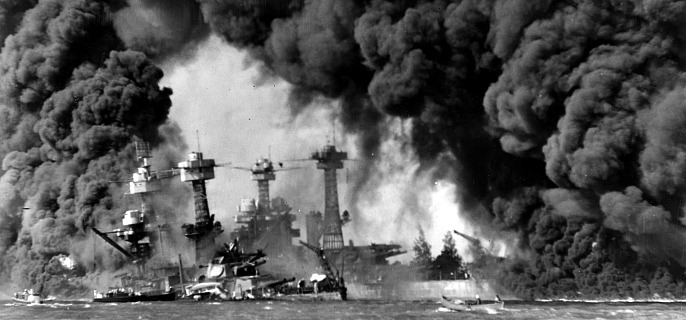
Editor’s note: Seventy-five years ago today, the Japanese attacked Pearl Harbor, marking the start of the United States’ entry into World War II. On this day, we look back on the attack with some facts and figures on the “day that will live in infamy.”
At 7:55 a.m., on Sunday, Dec. 7, 1941, the Japanese attacked the United States which launched our nation into World War II and changed the course of history.
Today marks the 75th anniversary of the day that President Franklin Roosevelt said would “live in infamy” (more on that line later). The surprise attack left more than 2,300 U.S. servicemen killed, more than 1,200 wounded and more than 900 missing.
The attack came in two waves, the second coming at around 8:40 a.m. The attack lasted a total of 110 minutes. To reach Pearl Harbor, the Japanese traveled 3,400 miles across the Pacific Ocean. The actual attack force stationed itself approximately 230 miles north of the Hawaiian island of Oahu.
The Japanese chose to attack on a Sunday because they believed Americans would be more relaxed and thus less alert on a weekend. In fact, many U.S. servicemen were either still in their pajamas or eating breakfast in the mess halls when the attack on Pearl Harbor began.
When Japanese Commander Mitsuo Fuchida called out, “Tora! Tora! Tora!” (“Tiger! Tiger! Tiger!”) upon flying over Pearl Harbor, it was a message to the entire Japanese navy telling them they had caught the Americans totally by surprise.
A total of 353 Japanese planes took part in the attack and struck airfields at Hickam Field, Wheeler Field, Bellows Field, Ewa Field, Schoefield Barracks, and Kaneohe Naval Air Station. Fortunately for the United States, its aircraft carriers, the primary target of the attack, were not at the base at the time. However, there were eight battleships at Pearl Harbor that day, which included all the battleships of the U.S. Pacific fleet except for one (the Colorado) and all eight were either sunk or damaged in the attack.
Little-known fact is that all but two (the Arizona and the Oklahoma) were eventually able to return to active duty.
The Arizona exploded when a bomb breached its ammunition room and approximately 1,100 U.S. servicemen died on board. After being torpedoed, the Oklahoma listed so badly that it turned upside down. The Japanese sent in five midget subs to help target the battleships, but the Americans sunk four of the midget subs and captured the fifth. In all, the Japanese lost just 65 men with one being captured by the U.S. The U.S. lost 11 other ships in the attack and 188 planes were destroyed. The Japanese lost just 28 planes.
The day after the attack, the U.S. declared war on Japan and Roosevelt gave his famous “Day that will live in infamy” speech. That line, however, was not in the original text of his speech. It originally said “a day that will live on in world history,” but FDR changed it at the last minute.
Three days later, the U.S. declared war on Germany and Italy after they declared war on the U.S.
To read President Roosevelt’s speech, click here.








